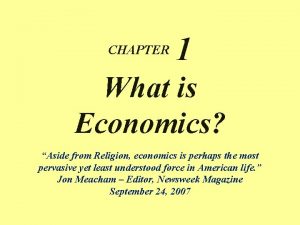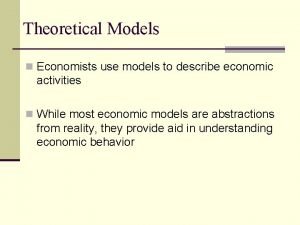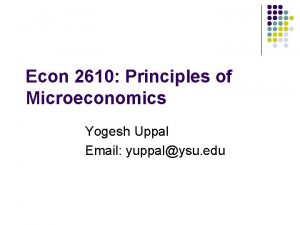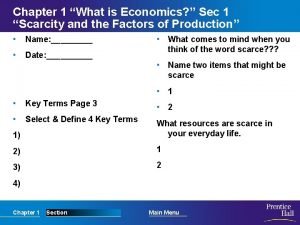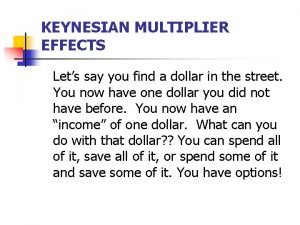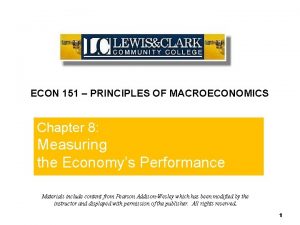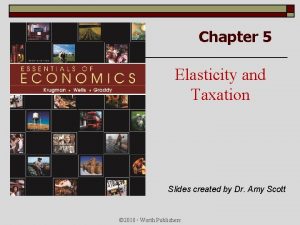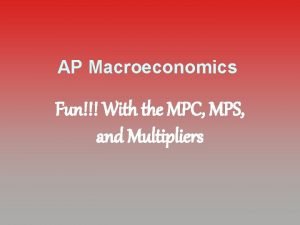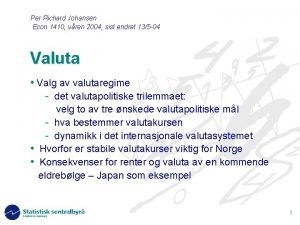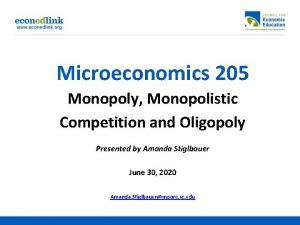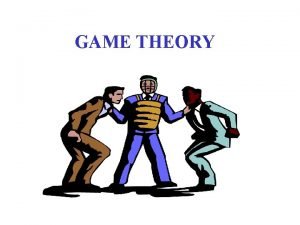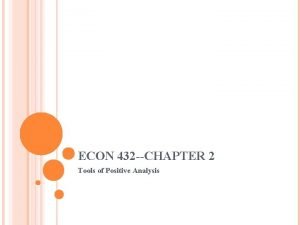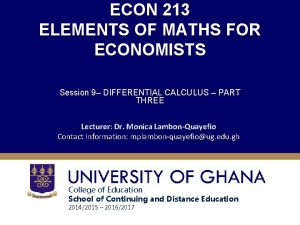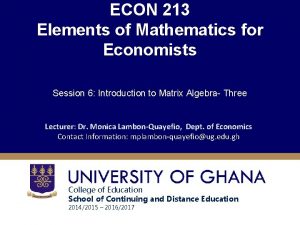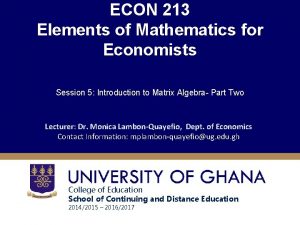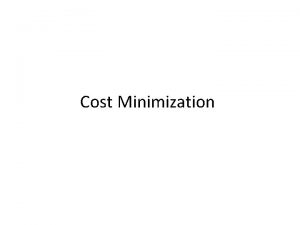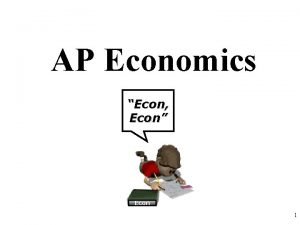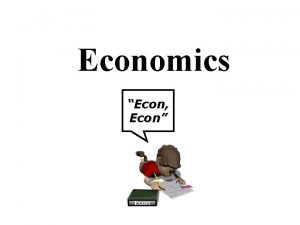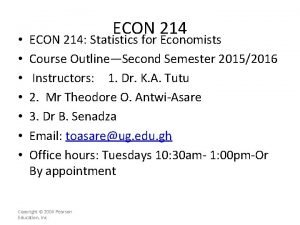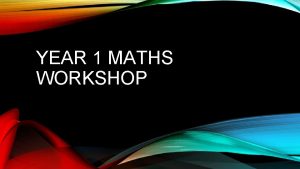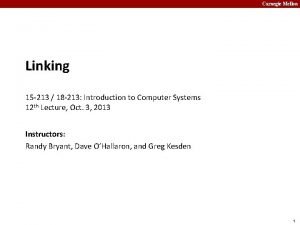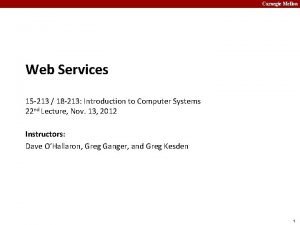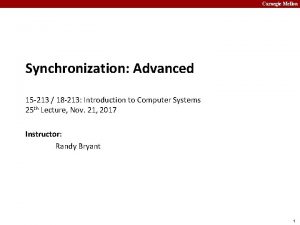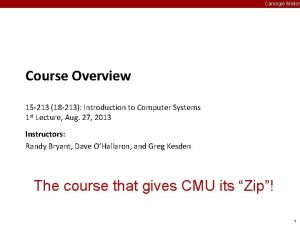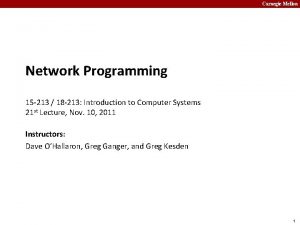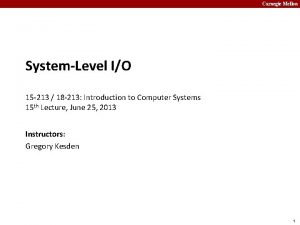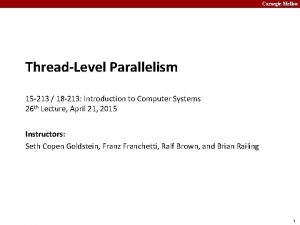ECON 213 ELEMENTS OF MATHS FOR ECONOMISTS Lecture



















- Slides: 19

ECON 213 ELEMENTS OF MATHS FOR ECONOMISTS Lecture 1– Nature of Mathematical Economics Lecturer: Kwame Adjei-Mantey Contact Information: kadjei-mantey@ug. edu. gh

� Instructors for Econ 213: �Kwame Adjei-Mantey �Course Email Address � Course Outline � Other Announcements �Dr. Monica Lambon-Quayefio �Dr. Bernardin Senadza �Course outline Econ 213 course outline 2017 -18. docx �Office Hours: Tuesdays, 2: 30 pm-4: 30 pm �Interim Assessment (TBA) Slide 2

Lecture Objectives Overview � This lecture introduces students to approaches used to solve economic problems. Specifically, the use of mathematical concepts will be introduced to students in this lecture. Objectives � Understand the differences between mathematical and non-mathematical economics � Understand the differences between mathematical economics and econometrics � Understand economic models and the components of same Slide 3

Mathematical vs Nonmathematical Economics �Mathematical economics is not a distinct branch of economics as is the case of public finance, international economics, or health economics etc. �It is an approach to economic analysis where mathematical symbols are used in stating economic problems and known mathematical theorems are employed to aid reasoning. �Mathematical economics is also described to go beyond simple geometry which presents the visual aspect of analysis. [Recall: demand curve as drawn in a 2 dimensional plan] � Mathematical economics as an approach does not Slide 4 differ from non mathematical approach to analysing

Mathematical and Nonmathematical Economics � The purpose of any theoretical analysis is: � to use the process of reasoning to derive conclusions or theorems from a given set of assumptions or postulates…. �Irrespective of the approach used. � The main difference between mathematical and non mathematical economics is: �in mathematical economics, the assumptions and conclusions are formally stated in mathematical symbols and equations �nonmathematical economics words and sentences Advantage: symbols are more convenient to use in deductive reasoning than words and sentences. � Symbols and equations are also more conducive to conciseness and preciseness of statements. •

Mathematical and Nonmathematical Economics �In summary, the mathematical approach offers the following advantages over nonmathematical approach to analysis: � The ‘language’ ie. Symbols, equations etc. is more concise and precise. � The approach taps into the wealth of mathematical theorems that exists for its analysis. � The mathematical approach also strictly requires economists to make their assumptions explicit at every stage of reasoning. �This way, the analysts clearly states all assumptions; �No room for unintentional adoption of unwanted implicit assumptions � The approach also helps the analyst to treat the

Mathematical Economics vs econometrics Slide 7

Mathematical Economics Versus Econometrics �Mathematical Economics is sometimes confused with a related term called Econometrics. �Econometrics is mainly concerned with the measurement of economic data while mathematical economics is mainly concerned with the application of mathematics to the purely theoretical aspects of economic analysis � little or no concern about statistical problems such as errors of measurement of the variables under study.

Mathematical Economics Versus Econometrics � This course focuses more on the application of mathematics to deductive reasoning which deals primarily with theoretical rather than empirical material. � It should however be noted that theoretical and empirical analysis are often mutually reinforcing. � For example, theories can be tested against empirical data for validity before they are applied with confidence. � Meanwhile, statistical work needs economic theory as a guide and an underpinning to determine the most relevant and fruitful direction of research.

Mathematical Economics Versus Econometrics: Illustration � A classic illustration of the complementary nature of theoretical and empirical studies is found in theory of the aggregate consumption function. � The theoretical work of Keynes on the consumption function led to the statistical estimation of the propensity to consume. � Statistical findings from Kuznets and Goldsmith regarding the relative long-run constancy of the propensity to consume in turn stimulated the refinement of the aggregate consumption theory by Friedman and others. � In one sense, mathematical economics may be considered as the more basic of the two. � This is because, to have a meaningful statistical and econometric study, a good theoretical framework usually based on mathematical formulation is necessary.

Economic models Slide 11

Economic Models � Like any theory, economic theory is an abstraction from the real world. � The complexity of the real economy makes it impossible to understand or study all the interrelationships at once. � The practical thing to do therefore is to pick out what appeals to our reason as the primary factors and the relationships relevant to the problem we wish to study and focus our attention on such factors or relationships alone – this is what an economic model basically does. � An economic model is a deliberately simplified analytical framework used to enhance our understanding of the actual economy.

Components of a Mathematical Model �An economic model is merely a theoretical framework. �If it is a mathematical one, it will usually consist of a set of equations designed to describe the structure of the model. �Relevant mathematical operations and formulae can then be applied to these equations to derive a set of conclusions which follow logically from the assumptions stated.

Variables, Constants and Parameters � Slide 14

Variables, Constants and Parameters � When properly constructed, an economic model can be solved to give us the solution values of a certain set of variables such as the market clearing level of price or the profit maximizing output level. � Such variables whose values are provided within the model are known as endogenous variables. � Sometimes, the model may also contain certain variables that are assumed to be determined by external forces outside the model whose values are accepted as given data. These variables are called exogenous variables. � It should be noted however that, a variable which is endogenous in one economic model may be exogenous in another economic model. � For example: In an analysis of the market determination of rice price (P), the variable P is definitely endogenous. However, in the framework of a theory of consumer expenditure, P would become an exogenous variable Slide 15 since P is instead a datum for the individual consumer.

Variables, Constants and Parameters � Variables usually appear in combination with fixed numbers or constants as in the expressions 9 P or 0. 2 Y. � A constant is defined as a magnitude that does not change. When a constant is joined to a variable, it is called the coefficient of that variable. � Sometimes, the coefficient may be symbolic rather than numerical. For instance the symbol a can stand for a given constant and used in the expression such as αP instead of 7 P in a model in order to attain a higher level of generality. � The symbol α is a special case- it is supposed to represent a constant but yet it is a variable. Slide 16

Variables, Constants and Parameters � Slide 17

Equations and Identities � Slide 18

Equations and Identities � Slide 19
 Pure competition
Pure competition To help unscramble cause and effect, economists
To help unscramble cause and effect, economists International association of maritime economists
International association of maritime economists Economists use models to
Economists use models to Yogesh uppal
Yogesh uppal How do economists use the phrase guns or butter
How do economists use the phrase guns or butter 01:640:244 lecture notes - lecture 15: plat, idah, farad
01:640:244 lecture notes - lecture 15: plat, idah, farad How to find mpc
How to find mpc Econ crowding out
Econ crowding out Flip it econ
Flip it econ Econ 151
Econ 151 Midpoint method formula
Midpoint method formula Mpc ap macro
Mpc ap macro Marginal analysis econ
Marginal analysis econ Sports econ austria
Sports econ austria Econ 1410
Econ 1410 Econ 424
Econ 424 Mr darp econ
Mr darp econ Game theory econ
Game theory econ Tools of positive analysis
Tools of positive analysis

